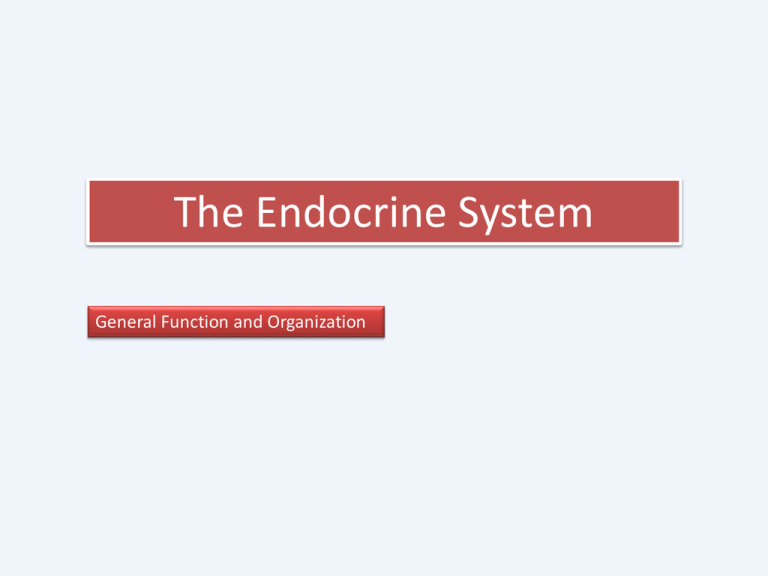File
advertisement

The Endocrine System General Function and Organization •Bethold found that a rooster's comb is an androgen-dependent structure. Following castration, the comb atrophies, aggressive male behavior disappears, and interest in the hens is lost. •Importantly, Berthold also found that these castration-induced changes could be reversed by administration of a crude testicular extract (or prevented by transplantation of the testes). I. Organization of Endocrine System The functions of the body are regulated by the nervous and the endocrine system. The endocrine system consists of endocrine glands and cells that secrete hormones in various tissues. Endocrine System • Regulates long-term processes: – growth – development – Reproduction • Uses chemical messengers to relay information and instructions between cells Endocrine glands: Glands that do not use ducts to convey the secretion to a neighboring target, they are also called ductless glands. The secretions, known hormones, circulate all over the body in the blood but may produce effects only in selected sites. The target organ(s) may or may not be near the site of production of the hormone. A hormone – --chemical substance --is secreted into the internal body fluids by one specialized cell or a group of cells and --has a physiological control effect on other cells of the body. Endocrine vs. Nervous System Major communication systems in the body Integrate stimuli and responses to changes in external and internal environment Both are crucial to coordinated functions of highly differentiated cells, tissues and organs Unlike the nervous system, the endocrine system is anatomically discontinuous. What are the modes of intercellular communication used by the endocrine and nervous systems? What is the functional significance of the differences between the two systems? • Endocrine System - Is unable to handle split-second responses • Nervous System - Handles crisis management Are similarly organized: 1. rely on release of chemicals 2. share many chemical messengers 3. are regulated primarily by negative feedback 4. share a common goal: to preserve homeostasis Hormones travel via the bloodstream to target cells •The endocrine system broadcasts its hormonal messages to essentially all cells by secretion into blood and extracellular fluid. •Like a radio broadcast, it requires a receiver to get the message – •in the case of endocrine messages, cells must bear a receptor for the hormone being broadcast in order to respond. Transportation of Hormones 1. Endocrine: glands or specialized cells release hormones into the circulating blood that influence the function of cells at another location in the body. Transportation of Hormones 2, Neuroendocrine: neurons secrete substances (neurohormones) that reach the circulating blood and influence the function of cells at another location of the body. Transportation of Hormones 3. Paracrine, in which cells secret substances that diffuse into the extracellular fluid and affect neighboring cells. What are the major structural classes of hormones? Chemical Nature of Hormones • Can be divided into 3 groups: – Derivatives of amino acid – Proteins and polypeptide hormones – lipid derivatives (steroids) Why is it important to know the chemical structures of different hormones? To determine:1. Synthesis , storage and release 2. The way a hormone is transported 3. Its half life and mode of clearance 4. Its medium of action (Receptors) Steroids can not be stored while Peptides are stored in secretory vesicles Derivatives of Amino Acid Tyrosine • Small molecules structurally related to amino acids • Synthesized from the amino acids tyrosine Tyrosine Derivatives • Iodothyronines (Thyroid hormones) • Catecholamines (water soluble): – epinephrine (E) – norepinephrine (NE) Peptide Hormones • Chains of amino acids • Synthesized as prohormones: – inactive molecules converted to active hormones before or after secretion • Water Soluble • Stored in the membrane bound secretory vesicles • Circulate in blood freely unbound • Usually administered by injection • Hydrophilic • Short half life • Signal through membrane receptors 2 Groups of Peptide Hormones • Group 1: –glycoproteins: • more than 200 amino acids long, with carbohydrate side chains: –thyroid-stimulating hormone (TSH) –luteinizing hormone (LH) –follicle-stimulating hormone (FSH) 2 Groups of Peptide Hormones • Group 2: –all hormones secreted by: • hypothalamus • heart • thymus • digestive tract • pancreas • posterior lobe of pituitary gland • anterior lobe of pituitary gland Synthesis, Storage and Release of Peptide Hormones Stimulus Lipid Derivatives (Steroids) Made by:Adrenal Cortex Ovaries Testes Placenta Kidneys Steroid Hormones • Synthesized from cholesterol • Can not be stored • Released by: – reproductive organs (androgens by testes, estrogens, and progestins by ovaries) – adrenal glands (corticosteroids) – kidneys (calcitriol) Steroid Hormones • Remain in circulation longer than peptide hormones • Are absorbed gradually by liver • Are excreted in bile or urine Hormones • Circulate freely or bound to transport proteins Free Hormones • Remain functional for less than 1 hour: – diffuse out of bloodstream: • bind to receptors on target cells – are absorbed: • broken down by cells of liver or kidney – are broken down by enzymes: • in plasma or interstitial fluids Thyroid and Steroid Hormones • Remain in circulation much longer • Enter bloodstream: – more than 99% become attached to special transport proteins Bloodstream • Contains substantial reserve of bound hormones









